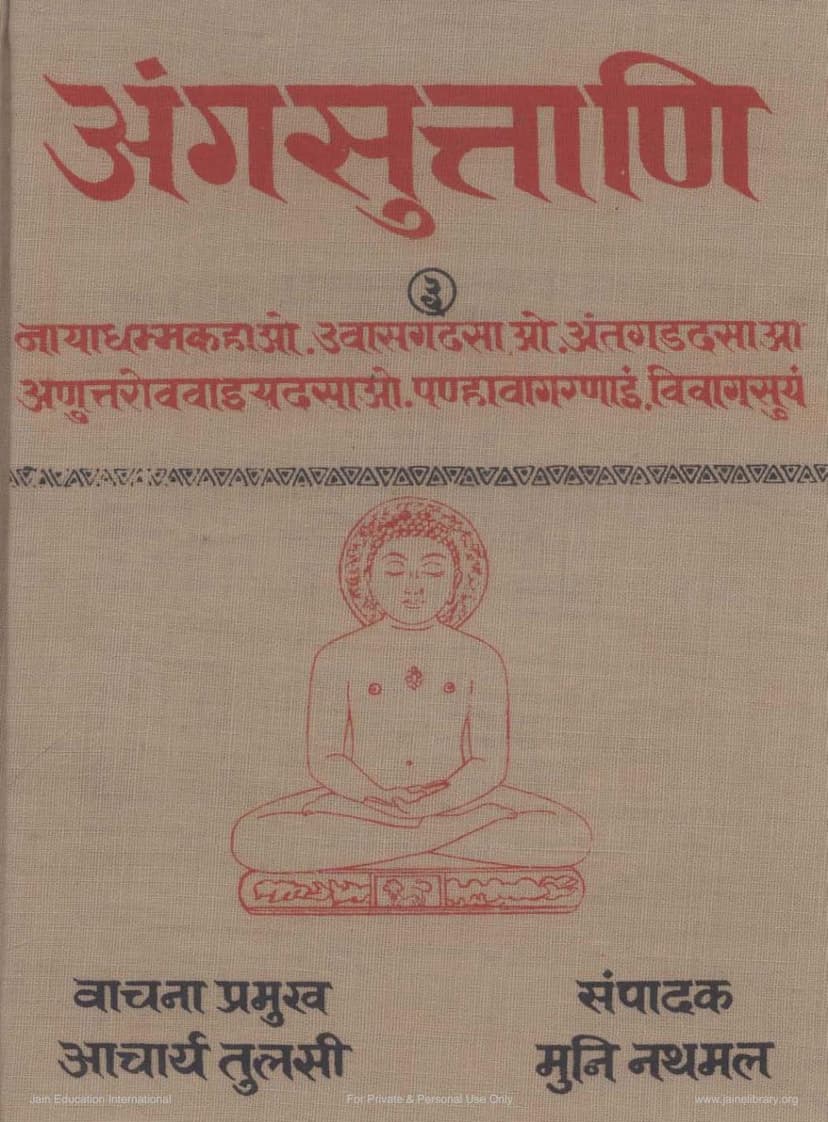Agam 11 Ang 11 Vipak Sutra Vivagsuya Terapanth
Added to library: September 1, 2025

Summary
This document is a critical edition and summary of the Vipākśruta, the eleventh Anga of the Jain Agamas, titled "Agam 11 Ang 11 Vipak Sutra Vivagsuya Terapanth." It was published by Jain Vishva Bharati, with Acharya Tulasi as the supervising authority and Muni Nathmal as the editor.
The text appears to be a comprehensive academic work, evidenced by the detailed preface, editorial notes, introduction to each of the six angas covered in this volume (Nāyādhammakahāo, Upāsakadaśāo, Antakaḍadaśāo, Anuttaraupapātikadaśāo, Praśnvyākaraṇāni, and Vipākśruta), and an extensive index of variants and references.
Key elements and summaries from the text:
- Book Title & Authorship: Agam 11 Ang 11 Vipak Sutra Vivagsuya Terapanth. Authors: Acharya Tulasi, Muni Nathmal. Publisher: Jain Vishva Bharati.
- Occasion of Publication: Released during the 25th Nirvana Centenary of Lord Mahavir.
- Core Content: This volume critically edits and presents six of the eleven Anga scriptures:
- Nāyādhammakahāo (ज्ञाताधर्मकथा): The sixth Anga, containing illustrative religious fables and narratives, some historical and some imaginary. It expounds spiritual elements like non-violence and sense restraint through engaging stories.
- Upāsakadaśāo (उपासकदशा): The seventh Anga, detailing the lives of ten lay devotees (upasakas). It outlines the twelve vows for householders and highlights the importance of conduct for lay Jains.
- Antakaḍadaśāo (अतकृतदशा): The eighth Anga, describing individuals who achieved liberation (ended the cycle of birth and death). It offers insights into spiritual practices and the impact of circumstances on human lives, emphasizing tapas (austerities).
- Anuttaraupapātikadaśāo (अनुत्तरोपपातिकदशा): The ninth Anga, focusing on monks born in the highest heavens (Anuttara Swarga). It describes the ascetic lives of princes and others who achieved spiritual heights.
- Praśnvyākaraṇāni (प्रश्नव्याकरण): The tenth Anga, dealing with various questions, sciences, and divine dialogues. The available content focuses on āśravas (influx of karma) and saṃvaras (cessation of karma).
- Vipākśruta (विपाकसूत्र): The eleventh Anga, describing the fruits (vipāka) of good and bad deeds. It has two parts: duḥkha vipāka (consequences of bad deeds) and sukha vipāka (consequences of good deeds), illustrating how actions affect one's life across various existences.
- Editorial Approach: The editors state they do not rely on a single manuscript but determine the original text based on meaning, context, earlier texts, and commentaries. They acknowledge minor errors in writing and some conceptual discrepancies, often attributing them to the process of transcription or integration of texts from different traditions.
- Manuscript Basis: The text identifies various manuscripts used for its preparation, noting their origin (e.g., Jesalmer Bhandar, Gardhya Library) and estimated age.
- Dedication and Gratitude: Acharya Tulasi dedicates the work to his spiritual family and expresses deep satisfaction in completing this scholarly endeavor during the significant 2500th Nirvana anniversary of Lord Mahavir. He credits Muni Nathmal and other disciples for their dedicated efforts.
- Structure of the Work: The book is presented as part of the "Anga Suttāṇi" series, with the eleven Angas being published in three volumes. This particular volume contains the third part. The preface also details previous publications in other series like "Agama-Anusandhāna" and "Agama-Anushilan."
- Significance: The publication aims to provide a well-researched and critically edited version of these foundational Jain scriptures, making them accessible to a wider audience, particularly during the auspicious occasion of Lord Mahavir's 2500th Nirvana year.
In essence, this is a scholarly work dedicated to the preservation, critical analysis, and dissemination of key Jain Agamas, reflecting a deep commitment to preserving spiritual knowledge and making it available for study and practice.